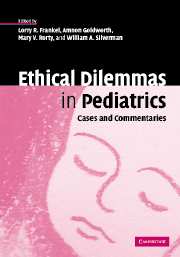Book contents
- Frontmatter
- Contents
- List of contributors
- Preface
- Introduction
- Part I Therapeutic misalliances
- 1.1 Unconventional medicine in the pediatric intensive care unit
- 1.2 Role responsibility in pediatrics: appeasing or transforming parental demands?
- 1.3 Topical discussion
- 2.1 The extremely premature infant at the crossroads
- 2.2 The extremely premature infant at the crossroads: ethical and legal considerations
- 2.3 Topical discussion
- 3.1 Munchausen syndrome by proxy
- 3.2 Some conceptual and ethical issues in Munchausen syndrome by proxy
- 3.3 Topical discussion
- Part II Medical futility
- Part III Life by any means
- Part IV Institutional impediments to ethical action
- References
- Index
1.1 - Unconventional medicine in the pediatric intensive care unit
Published online by Cambridge University Press: 18 August 2009
- Frontmatter
- Contents
- List of contributors
- Preface
- Introduction
- Part I Therapeutic misalliances
- 1.1 Unconventional medicine in the pediatric intensive care unit
- 1.2 Role responsibility in pediatrics: appeasing or transforming parental demands?
- 1.3 Topical discussion
- 2.1 The extremely premature infant at the crossroads
- 2.2 The extremely premature infant at the crossroads: ethical and legal considerations
- 2.3 Topical discussion
- 3.1 Munchausen syndrome by proxy
- 3.2 Some conceptual and ethical issues in Munchausen syndrome by proxy
- 3.3 Topical discussion
- Part II Medical futility
- Part III Life by any means
- Part IV Institutional impediments to ethical action
- References
- Index
Summary
The Lord hath created medicines out of the earth: and he that is wise will not abhor them.
Ecclesiasticus 38: 4Introduction
Patients commonly use unconventional medical therapies such as chiropractic medicine, acupuncture, and herbalism to treat a variety of medical conditions. Many physicians have incorporated some unconventional therapies into their practice. Moreover, many third-party payers reimburse patients for a variety of unconventional therapies. It is less common to use unconventional therapy to treat a critically ill infant. In this case, a mother demanded that the medical staff use herbal therapy on her infant who was recovering from septic shock.
The case
Ericka was a vigorous 7 pound 12 ounce (3.5 kg) term baby girl. She stayed in the hospital two extra days after birth for evaluation of a low-grade temperature. At ten days of age, she developed a runny nose and a cough. Her mother, Melody, continued to breast-feed and gave her some of the special herbal tea she had used during the pregnancy. Two days later, Melody took her infant to the emergency department because she was lethargic, fed poorly, and breathed heavily.
In the emergency department, Ericka was in moderate respiratory distress. Her respiratory rate was 65 breaths per minute, her heart rate was 160, and her blood pressure was 65/40. Her color was pink, but her skin was slightly cool and her mucous membranes were dry. Bilateral crackles were heard over both lung fields. The rest of her exam was normal.
- Type
- Chapter
- Information
- Ethical Dilemmas in PediatricsCases and Commentaries, pp. 13 - 20Publisher: Cambridge University PressPrint publication year: 2005



